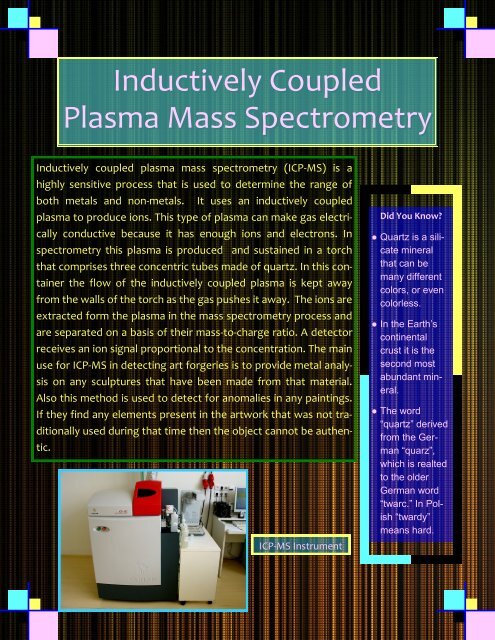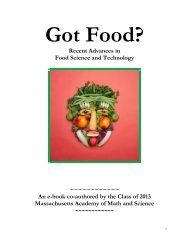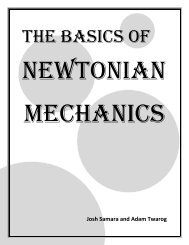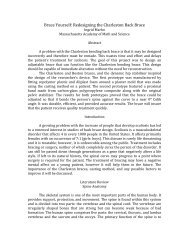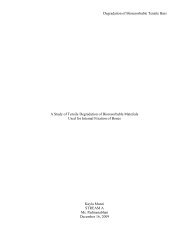Art Forgeries and Their Detection - the Scientia Review
Art Forgeries and Their Detection - the Scientia Review
Art Forgeries and Their Detection - the Scientia Review
Create successful ePaper yourself
Turn your PDF publications into a flip-book with our unique Google optimized e-Paper software.
Inductively Coupled<br />
Plasma Mass Spectrometry<br />
Inductively coupled plasma mass spectrometry (ICP-MS) is a<br />
highly sensitive process that is used to determine <strong>the</strong> range of<br />
both metals <strong>and</strong> non-metals. It uses an inductively coupled<br />
plasma to produce ions. This type of plasma can make gas electri-<br />
cally conductive because it has enough ions <strong>and</strong> electrons. In<br />
spectrometry this plasma is produced <strong>and</strong> sustained in a torch<br />
that comprises three concentric tubes made of quartz. In this con-<br />
tainer <strong>the</strong> flow of <strong>the</strong> inductively coupled plasma is kept away<br />
from <strong>the</strong> walls of <strong>the</strong> torch as <strong>the</strong> gas pushes it away. The ions are<br />
extracted form <strong>the</strong> plasma in <strong>the</strong> mass spectrometry process <strong>and</strong><br />
are separated on a basis of <strong>the</strong>ir mass-to-charge ratio. A detector<br />
receives an ion signal proportional to <strong>the</strong> concentration. The main<br />
use for ICP-MS in detecting art forgeries is to provide metal analy-<br />
sis on any sculptures that have been made from that material.<br />
Also this method is used to detect for anomalies in any paintings.<br />
If <strong>the</strong>y find any elements present in <strong>the</strong> artwork that was not tra-<br />
ditionally used during that time <strong>the</strong>n <strong>the</strong> object cannot be au<strong>the</strong>n-<br />
tic.<br />
ICP-MS Instrument<br />
Did You Know?<br />
● Quartz is a silicate<br />
mineral<br />
that can be<br />
many different<br />
colors, or even<br />
colorless.<br />
● In <strong>the</strong> Earth‟s<br />
continental<br />
crust it is <strong>the</strong><br />
second most<br />
abundant mineral.<br />
● The word<br />
“quartz” derived<br />
from <strong>the</strong> German<br />
“quarz”,<br />
which is realted<br />
to <strong>the</strong> older<br />
German word<br />
“twarc.” In Polish<br />
“twardy”<br />
means hard.


